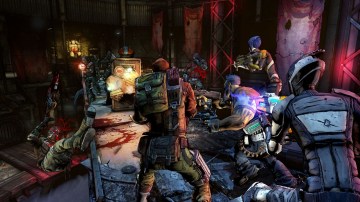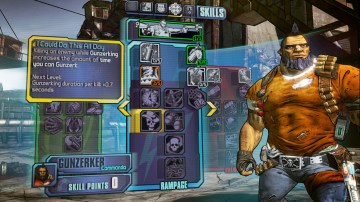The best thing about Borderlands 2 is that it doesn’t feel like an empty, exploitative raid on our dopamine supplies.
You couldn’t say the same about the original Borderlands, which merely proved that the numbers game of Diablo-style role-playing, combined with a first-person shooter, made for a frighteningly addictive brew. Borderlands had a weak plot, cardboard characters and maddening repetition–yet once you got hooked, it was impossible to stop playing.
(MORE: 7 Things I Learned After 15 Hours with Borderlands 2)
Borderlands 2 fixes the first game’s failures. There’s a plot, there’s variety, and the original, intoxicating RPG formula is unaltered. Still, the sequel isn’t flawless either. It falters on the little things–the many nuisances that introduce impurity into what is otherwise a fine finished product.
At first, Borderlands 2 seems like another tale of opportunity, with four “vault hunters” looking for untold treasures on the planet Pandora, but the story turns darker as the opening cutscenes unfold. Handsome Jack, head of the interplanetary corporation Hyperion, has taken over Pandora, and has his own plans for the alien resource Eridium released throughout the planet after the first game. His sabotage of the vault hunters leaves them in grave condition before they even handle their first firearms.
It turns out that Jack’s meddling, combined with breakout of Eridium, has left Pandora even more disfigured than it was in the original Borderlands. Whereas the first game was dominated by deserts, much of Pandora in Borderlands 2 is either frozen over or covered by Hyperion’s metallic sheen, with the occasional patch of desert or lush greenery dotted throughout. (On the bright side, this gives the game a much broader color palette than its predecessor.)
All of this sets the stage for a better plot than the original game, dotted with unexpected twists, a few emotional moments and gobs of potty humor and dark comedy, just so you don’t take anything too seriously. The cast in Borderlands 2 is still two-dimensional, but at least now they walk, talk and converse with one another, so you actually feel like you’re part of a world, rather than a soulless RPG construct. The one exception to the game’s otherwise banal cast is Handsome Jack, who at first calmly brags of his heinous crimes to the player via radio, but eventually exposes a load of baggage, vulnerability and rage. By the game’s conclusion, you might even think the story is about him, not the heroes.
It’s not just the plot that gives Borderlands 2 more depth than its predecessor. The action, now refined and expanded, is as inherently rewarding as the loot you collect after each big battle. You’ll descend into pits full of wild beasts, catch air in a rocket-mounted SUV to land directly in a camp full of angry bandits, fend of hordes of robots while your allies try to secure your safety and face off against some humongous bosses. The slog of the original Borderlands is mostly gone, replaced by a steady drip of set pieces, new enemies and interesting objectives. Even the game’s side missions tend to reveal new facets about life on Pandora, making them all the more enjoyable to pursue.

2K Games
Combat in Borderlands 2 is the polar opposite of popular military shooters like Call of Duty. You don’t simply pop an enemy in the head and move on to the next one. Instead, you take stock of the little numbers that squirt from your opponents’ wounds, and watch how fast their health bars drop. You ask yourself whether the weapons you’re carrying are doing enough damage. When all your foes have fallen, you scour the area for equipment that might do a better job. Similar to action RPGs like Diablo, you’re playing a game of damage per second.
The difference here is that even the best weapons won’t save you if your action gaming skills aren’t up to snuff. Everything moves at a rapid clip in Borderlands 2, and cover is essential, not just to dodge enemy fire, but to let your character’s action skill recharge.
The game’s Assassin character, for instance, can drop a decoy and turn invisible, and the Gunzerker can wield two weapons at once. The Siren can ensnare enemies, and the Commando can deploy friendly turrets. You can improve these skills by gaining experience, so by the end of the game you’ll be frantically waiting for the next opportunity to unleash them. In the meantime, you’ll need sharp aim and a keen awareness of who’s around you, as enemies are smart enough to flank and find their own cover.
The problem with Borderlands 2’s action is not a lack of variety, but some puzzling tendencies that prevent you from seeing more cool stuff. One frustrating example is the way enemies respawn even before you’ve left an area, so any necessary backtracking brings extra headaches. The game also tends to offer side missions in areas you’ve just visited, essentially making you play through the same level twice in a row. The strange thing is that even while the game sends you on repetitive quests, entire patches of the game world remain uncovered.
Borderlands 2 also slows you down in other ways. You can’t mark more than a single quest on your map at once, so if you’re trying to complete more than one in a given area, you must pause and switch to keep an eye on both. Some quests require you to kill several enemies in a certain way, but the area doesn’t supply enough enemies to do so. One mission required a specific type of weapon to complete, but the objectives list didn’t make this clear at the outset, so the only way to finish it was to leave, find the necessary weapon at a vending machine, come back, and fight through the respawned enemies to finally finish the quest. Also, while some of the game’s boss battles left my heart pounding, others simply required me to keep a safe distance and fire a sniper rifle ad nauseam.

2K Games
My other major complaint with Borderlands 2 is the slow pace at which your character gains new skills. I spent about 25 hours playing through the whole game, mainly in single player, with a good mix of side quests and story missions. Only after the final boss battle did I earn enough experience points to reach the top of my character’s skill tree. (There are three skill trees for each character, and each one has three additional points of divergence.)
Of course, you can keep playing at higher levels once you’ve beaten the game, but Borderlands 2 should have offered more room to dabble in different types of skills in a single play-through. If you want to hit the elite skills at the top of any given tree, many of your character-building decisions are laid out ahead of time.
This is not the last we’ll hear of Borderlands, as the conclusion to Borderlands 2 sets up at least another sequel. But with all the major weaknesses of the first game now corrected, the challenge for 2K Games is to expand the series in even more exciting ways, and not just to smooth over the last remaining rough spots to give us the finely-polished Borderlands that the second game could have been.
Then again, no matter what’s next for Borderlands, even if it slides backwards, we’ll all be hopelessly addicted to it anyway.
Score: 4 out of 5 (PC version reviewed)

